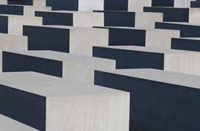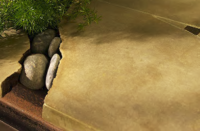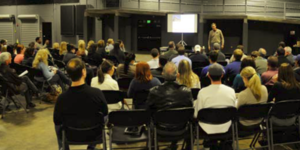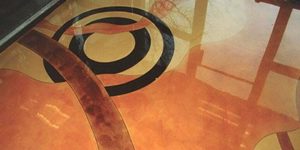 You’ll need:
You’ll need:
- Artist’s acrylic paint in yellow, blue, red, black and white
- Several 3/4-inch-wide, flat-bristle brushes
- 2 14-by-14-inch poster boards
- Compass and pencil
- Paper plates
- Scrap paper
- Glue
With a pencil and compass, draw two concentric circles on each poster board, with the outer circle about 10 inches in diameter and the inner one about 5 1/2 inches. Using the hole left by the compass as a guide, find and mark 12, 3, 6 and 9 o’clock. Then section the circles into 12 equal spaces. One board will be used to make the color wheel while the other one will be cut into pieces so you can make your color swatches. You probably should cut a few extra swatches for trial and error. About 20 swatches is good.
For the best results, you need to buy the most brilliant, saturated primary colors you can find. I use Cadmium Yellow, Ultramarine Blue and Cadmium Red Medium as my primaries. These three primary colors will be used to make every color on your wheel. If you opt to buy a beginner’s set of paints or dyes, it will include the primary colors, plus black and white and some secondary colors.
First paint your three primary swatches and glue them at three equidistant spaces around the wheel, so that the yellow is at 12, blue at 4 and red at 8 o’clock.
Now mix the secondary colors, which are made, in theory, from equal amounts of the primaries on either side of them. So, green will be mixed using half primary yellow and half blue. Place this painted swatch between them at 3 o’clock. Since artist’s acrylics and oils do not come in exact primary colors, you may have to fudge a bit to get a close match. You’ll also find when you try to mix half blue and red to get violet, so much light is absorbed by the two darkest primaries that you must “cheat” by adding white to obtain a color that looks like violet.
Save extra blobs of your chosen secondary colors on the palettes, since the wheel’s next colors, called tertiaries, are mixed half and half from neighboring colors on each side. For example, yellow-green is made from primary yellow and the green secondary on the other side of it. Finish your wheel by mixing and placing all the tertiary colors.
Disposable plastic lunch plates make fine palettes for mixing colors with a bent-handled palette knife. When you have your correct color, paint a swatch evenly on scrap paper, set aside and let dry before applying glue to the underside and attaching it in place on the wheel. You might need to mist your palettes now and then with water to keep the paints from drying too fast.















